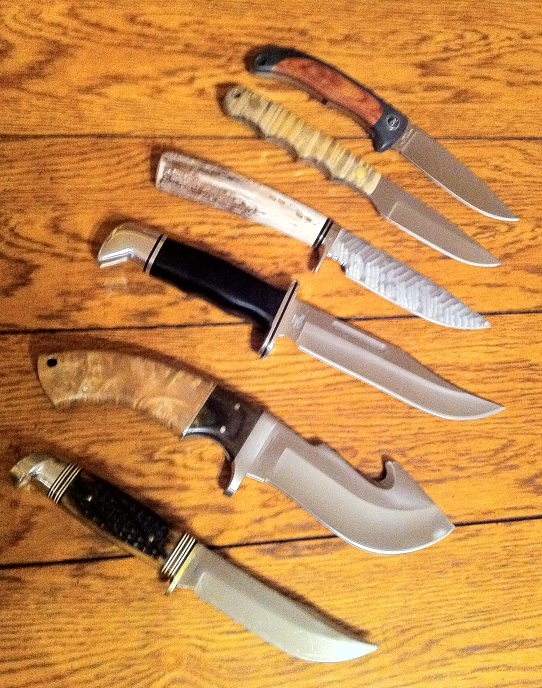
12 Jan Choosing The Best Hunting Knife
Hunting knives are an important part of the hunt. Many hunters pride themselves using huge Bowie Knives, or custom, super sharp, cutters. There are many great choices out there. Here are some suggestions.
Years ago, I came home from school and zipped out the back door to deer hunt. Homework could wait. I had a date with a buck! Sure enough, I was able to arrow a little 6- pointer. After tagging the buck, I went to gut the deer before dragging him home. I was in such a hurry that I forgot to bring a knife.
I did have a pair of tree pruners that I carried on my fanny pack belt. Out came the pruners, and after a little struggling, I was able to cut the deer open and do the gutting deed! The pruners worked well.
If all you need to do is gut a critter, a sharp rock can also do the trick. We have all heard stories of hunters using broken glass or a razor blade to dress their critters. If you want to cape, butcher, or take off lower legs, then you will need some other tools. A Wyoming Saw is a great cutting tool if you need to cut and quarter a bigger deer or elk. This compact tool comes in a case and disassembles easily. The 2 saw blades are helpful to cut bone or wood. After use, it cleans easily.
The Classic BUCK 5-inch hunting knife has been around forever. Good steel in this knife allows it to hold an edge. The sheath has a button snap to avoid losing it. The stiffer blade, is also handy to de-joint bones. The knife is one piece and virtually indestructible.
My all- time favorite blade is a newer knife that entered the market a decade or so ago. The Outdoor Edge Swing blade knife has 2 specific blades that switch position. One blade is for gutting and the other is for cutting. Each blade is only 4 inches long and has a specific function. The gutting blade works well when cutting the hide from tail to skull in one smooth motion. It also allows you to open the body cavity without cutting the wrong stuff. The wide cutting blade will do the rest of the butchering and trimming chore.
The original blades came with a black handle but now are available in blaze orange. You want a colorful handle that will not get lost in the guts, or forest litter. The first elk I used this knife on was in deep snow. At some point, the black handled knife went missing. The next spring, while shed hunting, I ventured back to the kill site. There, stuck in a log was my knife. 20 yards away was a nice elk antler shed. Never leave a good knife behind.
The proper knife will also allow you to field butcher your critter on site, where the law allows. In this way, you can quarter, trim, and bag your meat afield. Transport is easier, and waste can be cleaned up by decomposers, and scavengers. Some states require that you leave proof of sex on the carcass. This means the privates must stay attached to a rear leg. Antlers on the cape, or off, must have the tag attached. I usually pin my tag inside the ear, so it doesn’t get pulled off. Electric tape is also handy to keep the tag attached to the antler.
Whatever blade you prefer, make sure that you have a decent sheath with a secure loop or snap system. Keep the blade attached to the belt of your belly strap on your hunting pack. That way, you will never be without your cutting tool. My drawer is full of knives that I have found over the years. Just random blades laying in the open, or left by a gut pile.
Carry a quick sharpening tool to hone the edge of your knife as needed. A sharper knife allows you to make quick work out of a nasty job. Plastic gloves are a must. You can purchase long gloves that go up to your shoulders. Honestly, covering your hands is enough. Roll up your sleeves to keep yourself clean. Take your time and use your knife minimally. If you are on a hill, let gravity be your friend. Cut the critter so that the blood and mess will flow downhill. Once most of the cavity is open, you can fold the sides back and reach in to cut a windpipe or lungs. Save some hand wipes from your last rib dinner to clean yourself afterwards.
Always carry a few band aids in your gear bag. If you cut yourself with a knife or sharp bone, you can clean and bandage the wound. Paper towels also are handy for the final clean. Dispose of the towels and gloves appropriately.
Duct tape is also a good emergency bandage. An elk hunting friend once cut himself severely with a huge 12-inch sheath knife. He was several miles in, on horseback. A late evening bull was being gutted in a hurry. The knife slipped and somehow, he cut himself along his entire left arm and shoulder. The massive wound need closed immediately. His shirt was left on and a roll of duct tape was snuggly wrapped around his arm and shoulder. The arm was then secured to his body to prevent movement, using the tape. On the horse he went and after a groggy few hours, he was in the truck and on the way to a hospital. The tape, saved him from bleeding out.
Anticipate safety needs before they are needed, and you will always be prepared or can prevent accidents form happening. Remember that hygiene is a part od being safe. Think clean and safe when preparing your food.
Stay sharp! Montana Grant
For more Montana Grant, visit his blog at www.montanagrantfishing.com.




